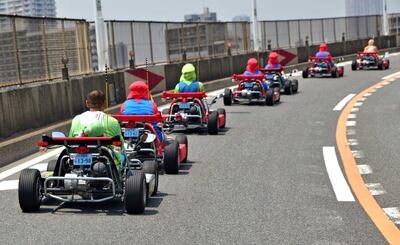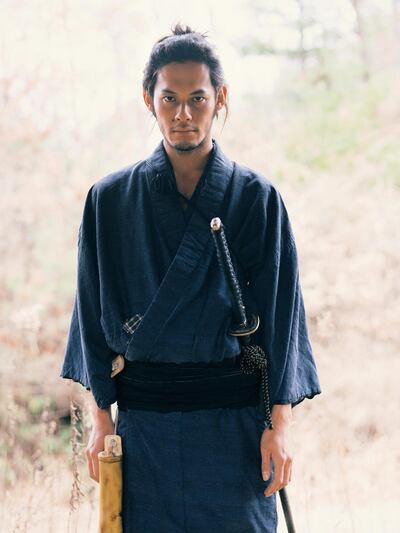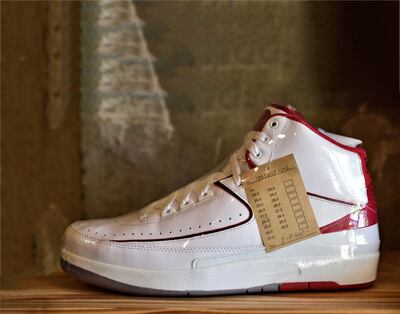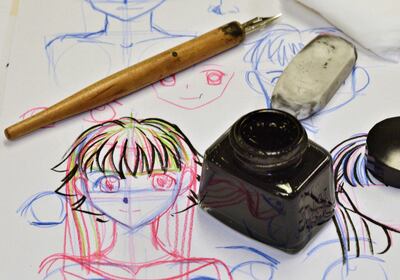Cherry blossom season may be in full swing and the 2020 Olympics is just around the corner, but the Japanese capital’s quirky subcultures have always been its greatest draw.
Scaled and scar
I’m spoiled for choice, yet I see no attractive options. The Brazilian rainbow boa is beautiful but it’s also big – really big. The Honduran milk snake has a cute name yet looks highly venomous. The Baron’s green racer is slender but has truly creepy eyes. “They are not dangerous,” says Hisamitsu Kaneko, clearly sensing my trepidation at the prospect of holding a snake.
As the manager of Tokyo Snake Centre, the city’s only snake cafe, he is used to dealing with jittery guests, who pay a Dh35 entrance fee and then another Dh20 to briefly hold one of the reptiles. “A lot of people are scared to hold it but if you relax, the snake will relax too,” he tells me.
I settle on the Baron’s green racer, which Kaneko removes from its glass tank in the centre of this busy cafe in Shibuya, one of Tokyo’s hippest suburbs. By the time this business opened in 2015, Tokyo was already in the grip of the animal cafe craze, with establishments dedicated variously to dogs, cats, rabbits and owls.
At first these places were quirky. Nowadays they’re very popular with locals, judging by the crowd inside this cafe watching me squirm under the weight of a bright green snake. As the serpent crawls on my arm and turns its head to stare me in the face, Kaneko asks if I’d like a cappuccino. “That sounds nice, thank you,” I reply. “But first let me deal with this snake.”
Cartoonish fun
Standing on a street corner in the city’s upmarket Ginza district, a Japanese businessman does a double take. Clearly, he can’t quite believe what he’s seeing. Weaving through the road traffic, past gleaming BMWs and Japan’s renowned Toyota Crown taxis, is a toad, a princess and a dinosaur. These three eye-catching characters are each driving their own small, motorised go-kart as they let out squeals of excitement.

It is no wonder the businessman is confused. Tokyo is a very reserved place, so much so that in some public spaces, even speaking on your mobile phone is frowned upon. Yet somehow a group of tourists is allowed to zoom through the city’s streets while dressed as gaudy characters from the Nintendo videogame Mario Kart.
This activity has become so popular that tourism company MariCar, which came up with the idea, now has branches all over Japan. For about Dh300, tourists can drive a 95kg kart for two hours through downtown Tokyo. The tourists taking part who I speak to say that the experience was “like living out a childhood fantasy” and the “most Tokyo thing ever”, in reference to the city’s reputation as a hub for all things quirky.
Samurai sense
This is really embarrassing. Forget being able to skilfully wield the weapon I’m holding, I can’t even manage to put it away properly. I did not know this until now, but there is a specific manner in which a Japanese katana should be worn. By holding it by my left leg, I am giving a sign of aggression, whereas it should be on my right side, to let those around me know I mean no harm.

I’m surprised by the seriousness with which I’m alerted to this mistake by Mr Matsuzawa, my samurai training instructor. This young Tokyo man has been a samurai for more than five years and, even while passing on his knowledge to tourists like me, he has no time for fools. Central figures in Japanese society from the 12th to 19th centuries, samurai were highly skilled warriors who became revered throughout the country for their swordsmanship.
These days, samurai are pop culture figures, thanks to their dynamic roles in comics, movies and television. That’s why so many tourists join samurai lessons, where they are taught about the warrior’s combat techniques, etiquette and customs.
Sneaking around
This is no ordinary sneaker store. I’m perusing the stock at Worm, one of the hottest sneaker shops in a city which takes this casual style of shoe very seriously. How seriously, you may ask? About Dh5,000 worth of seriousness.
That’s the price for a single pair of sneakers stocked by Worm – the highly sought-after Nike Hyper Adapt 1.0, a cutting edge shoe embedded with technology that senses the dimensions of your foot and then laces itself. Worm is one of more than a dozen stores in Tokyo that specialises in vintage or limited edition sneakers, ranging from modern designs like the Hyper Adapt back to 1970s versions like Adidas Stan Smiths.

Collecting such rare sneakers has been a popular hobby for decades and Japan has been a centre of this subculture since the mid-1990s. Sneaker collectors from around the world travel to Japan to find uncommon designs released only in Asia.
Suspended in animation
I suppose you could call what I’ve just done a drawing. Perhaps even a sketch. But this wonky pencil design certainly isn’t art. Yet Nao Yazawa disagrees. She tells me I’m being too hard on myself, that I’m not too far from producing something worthy, and I suppose I should listen to her, considering that she is a professional Manga artist. This style of comic book is one of Japan’s most significant cultural exports. Undoubtedly, it is the country’s most famous pop culture product, thanks to the dynamic style of its art and the outlandishness of its storylines. Manga comics can be found in children’s bedrooms in virtually every part of the world.

Many aspiring Manga artists travel to Tokyo to be tutored by accomplished comic artists such as Ms Yazawa. There are also many tourists with limited artistic ability, like myself, who attend more basic lessons on comic art in Japan. As she describes the history of manga, which goes back to the 12th century, Ms Yazawa reminds me that the eyes are the key to drawing an engaging character. Right now, my own eyes are telling me I’ve messed up the character’s eyes. I erase them and start again.





